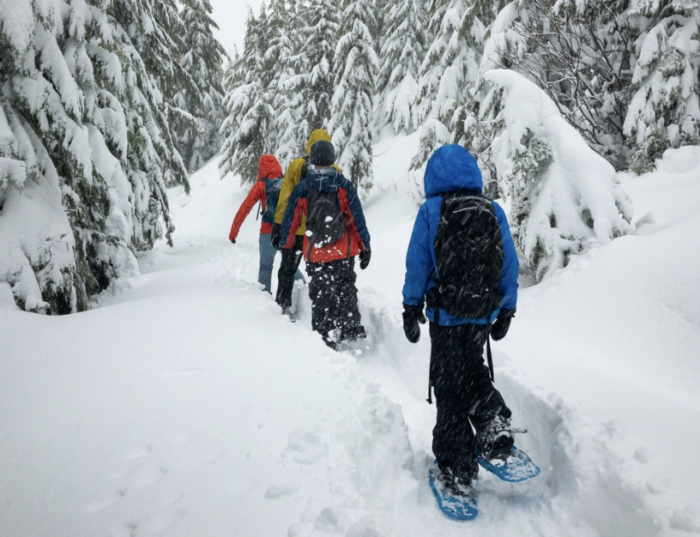Summer has left the high country. The gray clouds are belching snow flurries this morning.
Instead of fleeting visitors, the flakes feel like they might decide to stay for a while. Through the soft light out my kitchen window, they fall, floating and making their way to the ground. They stick and accumulate, and things turn white. The oven clock reads 5:48 p.m. I am ready to crawl under the covers and go to bed.
Rick Bass is a fiction and creative nonfiction writer. He lives in the Yaak Valley in northwestern Montana and writes about winter. He says, “It all comes together in these mountains. Not without irony, mountains and winter can be frightening.”
I have lived near the mountains for all but eight years of my life. I traveled west when they weren’t close—a visitor in those places I used to call home. Once when I was living in Chapel Hill, North Carolina, my friend asked me about my experience living in the small southern town. My response was, “It is really flat.”
There was no mention of the abundant southern cuisine, the intimate neighbors, the charming architecture, the university, or the lush hardwood forests. It felt flat, and while I ate my share of shrimp and grits, picked up another degree, and learned a lot about white linen and sassy sandals, I spent my time finding higher places.
The United States Geological Survey (USGS) was entrusted with the responsibility for mapping the country in 1879 and has been the United States’ primary civilian mapping agency ever since. The best known USGS maps are the 1:24,000-scale topographic maps, also known as 7.5-minute quadrangles.
I describe places based on the contour lines. I have been known to label topographic quadrangles unsafe emotional places. This kind of spatial consciousness is both a curse and a blessing. We live at 8,120 feet on the south side of a shallow plateau inside a topographic oval representing flat. The latitude is -105.27120. Below us and to the south, the contour lines are close together and curvy representing a radically steep descent. If you talk to me for long, you’ll learn that maps are mental representations of my emotional environment.
Topography, trails, and landmarks have been encoded into my memories at a neurological level.
For example, I have been triggered by the setting sun over Devil’s Head mountain. I imagined what it might look like from the view of an alternate position and started to sob big alligator tears. I might write a book about this phenomenon one day. I think of it as a superpower.
Some days, my boys think we’ve made a mistake living up here on this hill surrounded by steep contour lines. I moved here 15 years ago, and I didn’t give much thought to what it might be like to be a 10-year-old boy without friends nearby. It is on their mind, and we talk about it a lot. Then, they remember how much space they have to breathe into.
The other day, while looking out his bedroom window, my 12-year-old son said to me, “I don’t think I will ever tire of this view.” Then he asked, “Do you?” I said, “No, baby—not ever.”
These days, our life is a form of rugged topographic wildness. With a few unexpected detours, first responders, and supportive guides, our little family is finding our way.
We, as a community, are residents of what A.B. Guthrie calls in his writing “the Front.” The Rocky Mountain Front is a strip of land east of the Continental Divide, including an edge of the plains, the higher benchlands, the foothills, and finally, the jagged wall of mountains. The unified geologic formation and ecosystem starts in Canada and continues to the South. We meet it here, and the Front seems to stand guard over both creatures and land.
I know the Front fairly well, particularly a section west of Denver—the place where the North Fork of the Platte flows. Just a few miles from my home, I can reach the trailhead to Cathedral Spires by bike and then foot. The cracks and immaculate slabs of granite are open most of the year and closed to people in the spring for nesting raptors.
I imagine young native American boys climbing the Cathedral to find their talismans, or medicine in the form of a bird or animal, forever held sacred to them after that.
My own boys and I walked along the river on Sunday. We wore flannel shirts. They searched for sticks, unwittingly waiting for their imagination to make those former branches entirely something else. They found deep snow to sink in while I told them not to get their feet wet. They played too close to the river for their mama comfort. They climbed those granite slabs, falling backwards sometimes, laughing while they rubbed the dirt and snow off of their hands.
Like brothers, they poked and taunted, and on occasion, my younger one was close to tears. He’s adaptable and strong though. He walks ahead of us toward himself, and he stops looking back. I admire him for that. It is important to know when to keep on walking.
This little valley of ours. It still stands as a geographical and historical oasis. In a life with so much change, there is consistency here. This place belongs to a different time scale. When the chaos comes, it brings things to a meaningful whole. Here, continuity, expectedly, unfolds horizontally and geographically. Thank god, we have the gift of unbroken spaces of wilderness as reminders.
Winter is here, my friends:
“Um, do we want it to be cold? We want the snow, desire the isolation, desolation, insulation, silence. It’s why we’re up here; it’s why everyone’s up here. Not a particularly flattering thing to admit, but we’re all on the run from something, and it makes us feel safe this isolation.” ~ Rick Bass
Slowly and deliberately, we follow the seasons. Like most things in life, winter is its own fit, and it is not for everybody. Winter covers some things and reveals others.
~








Read 9 comments and reply